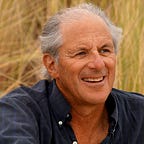Bring Manufacturing Home to the Heartland And Power It Up With Renewable Energy
Rebuilding “better, greener and fairer” on the bones of the once-thriving industrial Midwest
Facing the worst economy since the Great Depression, we Americans find ourselves compelled to take decisive action to revive our flagging fortunes. It’s finally time to bring our manufacturing home to the Heartland, the Great Lakes states that constituted the core of American industrial might in the mid-twentieth century and the Great Plains states that possess the nation’s vastest reservoir of renewable energy — wind, sun and switchgrass biomass. The factories, foundries and warehouses, highways and rail lines are all still there, dormant yet serviceable. Building on the bones of that infrastructure we can create a renewably powered, low-carbon 21st-century manufacturing base equal to and ultimately greater than what gave us our domestic strength, national security and working-class prosperity in the postwar decades.
What better use of the Midwest’s infrastructure and its motivated workforce than to put Heartlanders to work retooling our manufacturing base, only this time using renewables to produce a new generation of energy-efficient, low carbon electrified transportation, appliances and other durable goods at the world-class standards of quality, safety and reliability that were once the hallmark of American-made products?
Cars, trucks, buses, trains and aircraft all urgently need to be electrified to achieve the ambitious goals cities and states must meet to forestall catastrophic natural disasters. The energy to produce them can be most cost-effectively generated by local solar microgrids and regionally sourced wind, now the world’s cheapest, cleanest and most abundant sources of energy. We’ve finally reached the tipping point where renewables trump every source of fossil fuel. The economics are indisputable.
The Great Lakes states boast the Big Ten’s great public universities, world-class research labs and large educated cohorts eager to apply their expertise to r&d to take renewables, energy efficiency, and building and transportation technologies to the next level. Innovation hubs like Cleveland, Columbus, Detroit and Indianapolis and mid-size industrial centers from South Bend to Youngstown can partner with tuition-free community colleges specializing in vocational education, retraining and up-skilling workers throughout the region to build and operate a low-carbon, energy-efficient 21st-century green industrial base. Extending the reach of their skill-building to nearby “left behind” neighborhoods and regions, they will spark economic renewal in communities abandoned, then devastated by the ill-considered offshoring of manufacturing to East Asia.
In 1865, journalist Horace Greeley advised us all to “Go West,” and so we did. Now we would be better advised to “Go Midwest.” In 2018, Rep. Tim Ryan (D-Youngstown) organized a Comeback Cities Tour that took Silicon Valley entrepreneurs and their Congressman, Ro Khanna, to Detroit, Flint, South Bend, Youngstown and Akron. They came away impressed with the eagerness and creativity of Midwesterners, a hunger for innovation that has gone flat in an overpriced, over-saturated Silicon Valley. In their recent book, “Jumpstarting America,” MIT economists Jonathan Gruber and Simon Jenkins identify 102 “innovation hubs” around the country that could spark a U.S. r&d and manufacturing renaissance. A hefty percentage of the highest-ranking hubs are located in the Great Lakes states.
Vice President Biden is already moving in this direction. In a July 9 speech in his home state of Pennsylvania, he called for a $400 billion, four-year increase in government purchasing of U.S.-based goods and services plus $300 billion in new technology r&d. He also proposed tightening current “Buy American” laws. Together with pledging to spend $2 trillion over four years to stabilize the climate and invest in clean tech innovation, he aims to reverse decades of an obsolete, self-destructive fossil-fueled agenda. The Vice President has set the table for a seismic shift in national energy priorities. Now’s the time to focus this national renewal project on the potential role of the Heartland as the epicenter of renewably powered manufacturing. “Build back better,” the title he has given to his initiative to revive domestic manufacturing, is a great start, re-establishing the reputation of “Made in America” for quality and reliability. And equally vital to reviving quality and durability are the two other key components of a balanced, comprehensive manufacturing revival: Build back better, greener and fairer.
The European Union has just adopted a $1 trillion euro “European Green Deal” for a 27-nation rapid transition to a renewably powered economy. China is pursuing its “Made in China 2025” initiative to become a world leader in ten tech-leading industries. Central bankers and mainstream economists agree that the only practical route out of a prolonged global downturn is a “green recovery.” Far from being unaffordable, building a renewably powered economy and domestic industrial base is best understood not as an unaffordable expense but both a shrewd and wise investment in a future of shared prosperity.
If we fail to match Europe and China, we will find not just one distressed region but our entire nation left behind in a fossil-fueled downward spiral of stagnation and decline. If, on the other hand, we focus our combined resources — national regional and local; public, private, nonprofit and civil society — on a renewably powered revival of our Heartland, the once-and-future industrial Midwest, our investment will yield economic, social and environmental benefits many times our initial investment. It may also be our last and only chance to heal the coastal-Heartland divisions tearing our country apart with a common project that proves the efficacy of a more resilient, just and robust economy for the entire nation.
Mark Sommer is a veteran syndicated columnist and radio host, born and raised in Ohio and now living in Northern California.
